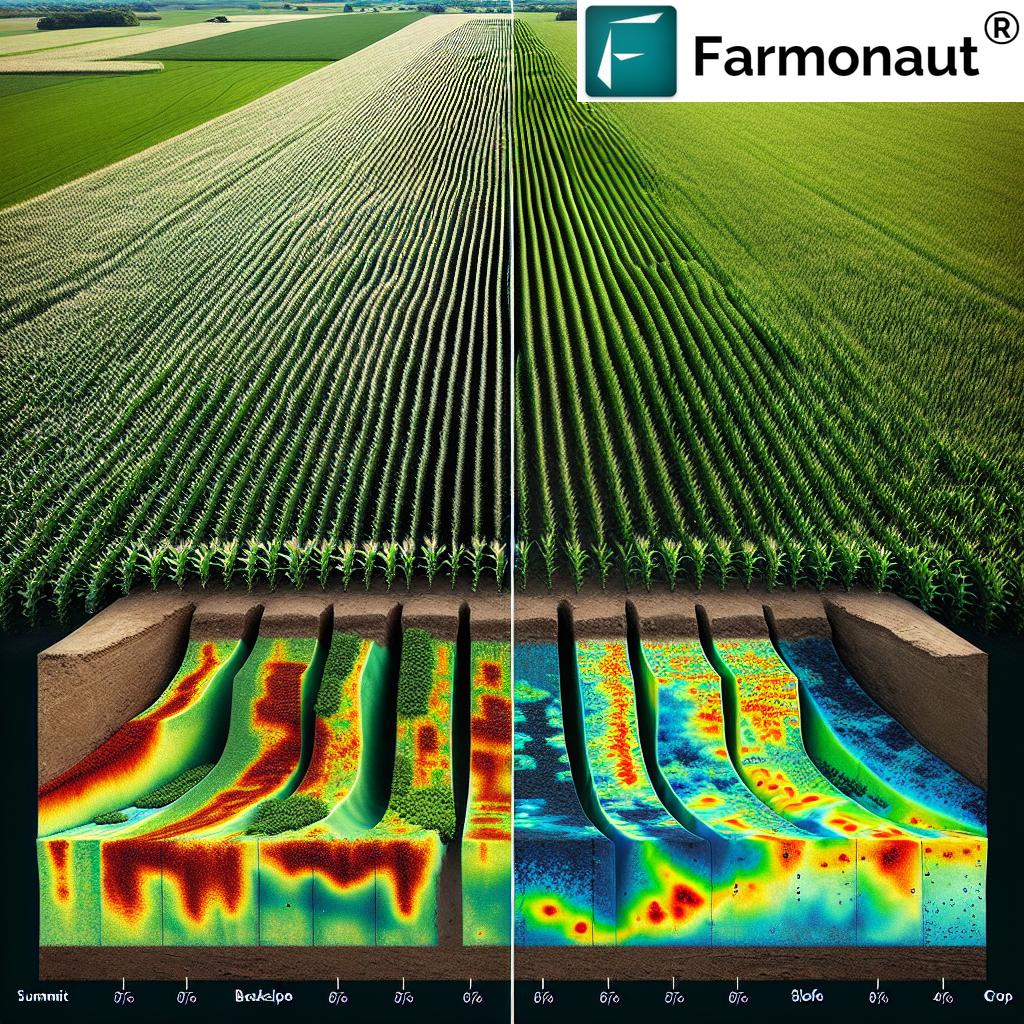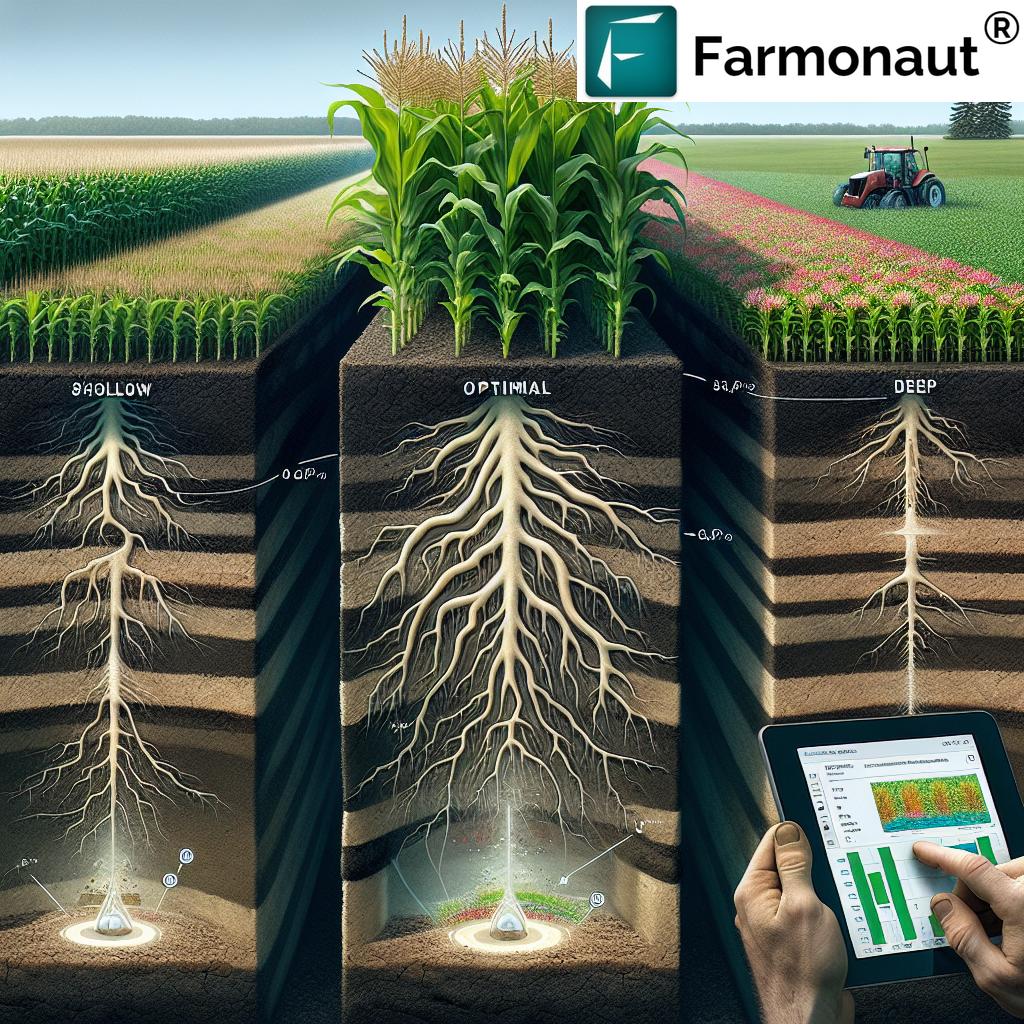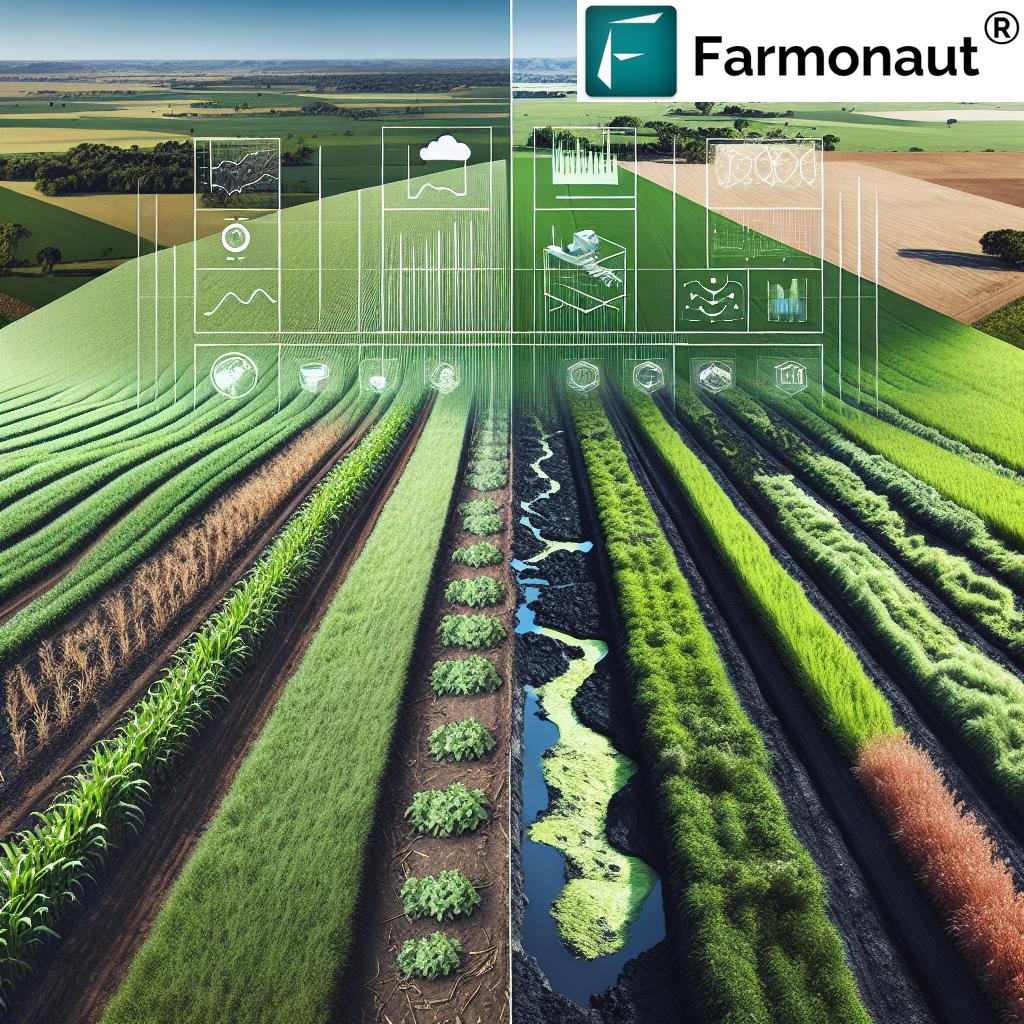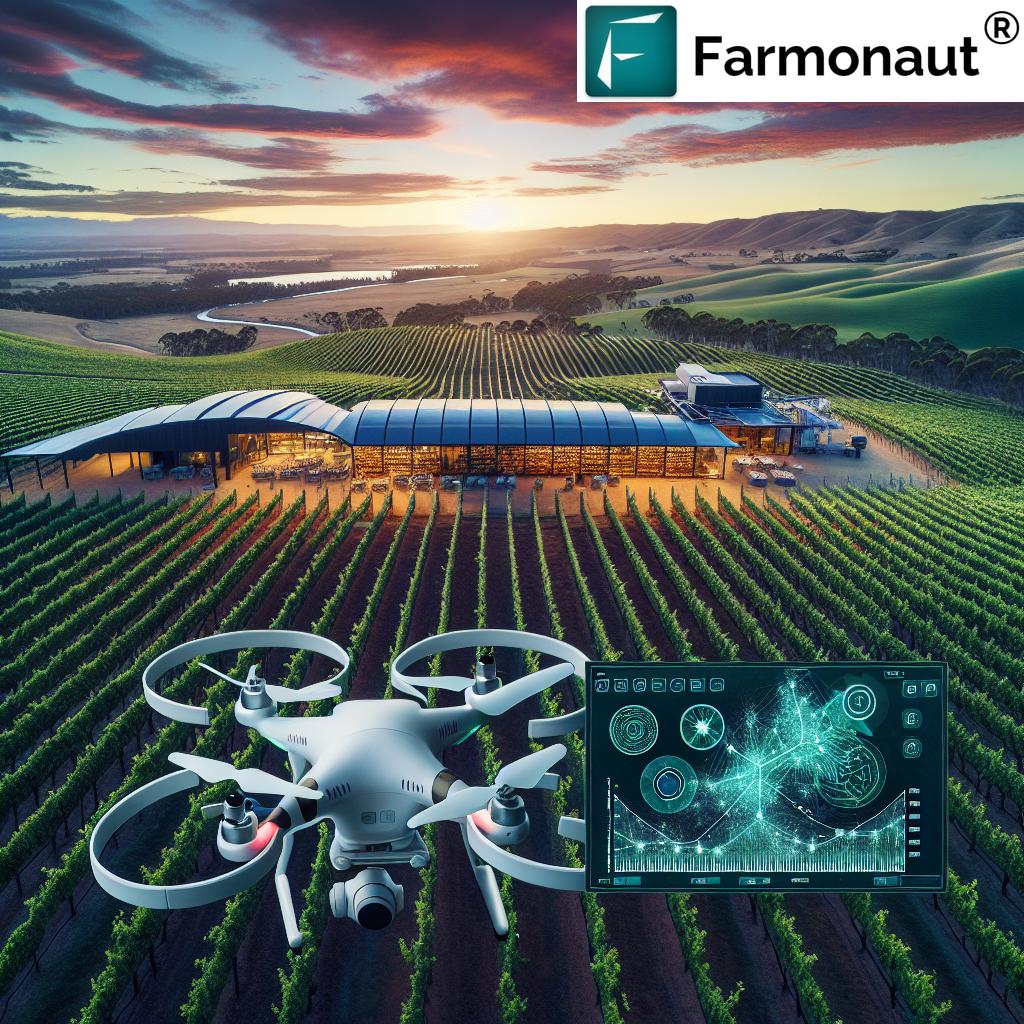Mastering Corn Emergence: How Planting Depth and Landscape Position Impact Yields in Missouri’s Claypan Soils
“Corn planting depth and landscape position can significantly impact crop emergence, with yield variations observed across summit, backslope, and foot slope areas.”
At Farmonaut, we’re committed to bringing you the latest insights in precision agriculture techniques. Today, we’re delving into a groundbreaking study that explores the intricate relationship between corn planting depth, landscape position, and crop yields in Missouri’s unique claypan soils. This research provides valuable information for farmers looking to optimize their planting strategies and maximize their corn production.
The Importance of Optimal Corn Planting Depth
Achieving the optimal corn planting depth is crucial for ensuring robust crop emergence and, ultimately, higher yields. Our study, conducted over two growing seasons in 2018 and 2019, sheds light on how various factors influence corn performance in the challenging environment of claypan soils.
Claypan soils, characterized by a dense, subsurface clay layer, present unique challenges for corn cultivation. These soils are prevalent in parts of Missouri and can significantly impact water movement and root development. Understanding how to manage these soils effectively is key to successful corn production in the region.

The Role of Landscape Position in Corn Emergence
Our research focused on three distinct landscape positions: summit, backslope, and foot slope. Each of these positions presents different soil conditions, affecting factors such as soil moisture, temperature, and nutrient availability. Here’s what we found:
- Summit: Generally well-drained with potentially lower soil moisture
- Backslope: Moderate drainage and soil moisture levels
- Foot slope: Tends to have higher soil moisture due to water accumulation
These landscape variations play a significant role in determining the optimal planting depth for corn in each zone.
Impact of Soil Temperature and Moisture on Germination
“A two-year study on claypan soils revealed crucial insights into how soil temperature and moisture affect corn germination rates in different landscape zones.”
Soil temperature and moisture are critical factors influencing corn germination and emergence. Our study revealed that these factors vary significantly across different landscape positions:
- Summit areas tend to warm up faster in the spring but may have lower soil moisture
- Foot slope areas generally have higher soil moisture but may warm up more slowly
- Backslope positions often represent a middle ground in terms of both temperature and moisture
Understanding these variations is crucial for determining the optimal planting depth in each landscape position.
Planting Depth Variations and Their Effects
In our study, we experimented with three planting depths:
- Shallow (1 inch)
- Medium (2 inches)
- Deep (3 inches)
Each depth was tested across the three landscape positions. Here’s what we discovered:
- Shallow planting (1 inch) often led to faster emergence but increased the risk of poor root development, especially in drier summit areas
- Deep planting (3 inches) provided better protection against moisture fluctuations but could delay emergence, particularly in cooler, wetter foot slope areas
- Medium depth (2 inches) generally offered a good balance, providing adequate moisture for germination while allowing for timely emergence across most landscape positions
Emergence Rates and Uniformity
One of the key findings of our study was the impact of planting depth and landscape position on corn emergence rates and uniformity. Emergence uniformity is crucial for achieving consistent crop development and maximizing yield potential.
Our data showed:
- Summit positions: Medium depth (2 inches) typically resulted in the most uniform emergence
- Backslope positions: A range between 1.5 to 2.5 inches provided good results, with some flexibility depending on soil moisture conditions
- Foot slope positions: Shallower planting (1 to 1.5 inches) often performed better due to higher soil moisture content
These findings highlight the importance of adjusting planting depth based on landscape position to achieve optimal emergence rates and uniformity.
Yield Implications of Planting Depth and Landscape Position
The ultimate goal of optimizing planting depth and considering landscape position is to maximize corn yields. Our study revealed significant correlations between these factors and final yield outcomes:
- Summit areas: Yields were generally higher with medium to deep planting depths, likely due to better access to soil moisture during dry periods
- Backslope areas: Medium planting depths consistently produced the highest yields across both study years
- Foot slope areas: Shallower planting depths tended to result in higher yields, possibly due to better soil aeration in these moisture-rich zones
These findings underscore the importance of tailoring planting strategies to specific landscape positions within a field.

Implications for Precision Agriculture
The results of our study have significant implications for precision agriculture techniques in corn production, especially in regions with claypan soils. Here’s how farmers can apply these findings:
- Utilize variable-rate planting technology to adjust seeding depth based on landscape position
- Incorporate soil moisture and temperature data into planting decisions
- Consider using GPS-guided planting systems to ensure consistent depth across different field zones
- Implement zone-specific management practices for fertilizer and irrigation based on landscape position
At Farmonaut, we offer advanced satellite-based crop monitoring tools that can help farmers identify different landscape positions and soil conditions within their fields. Our Farmonaut Web App provides real-time insights into crop health and soil moisture levels, enabling more informed planting decisions.
Soil Management Strategies for Claypan Soils
Managing claypan soils requires specific strategies to overcome their unique challenges. Based on our research, we recommend the following soil management practices:
- Implement conservation tillage practices to improve soil structure and water infiltration
- Use cover crops to enhance organic matter content and soil health
- Consider subsurface drainage in foot slope areas to manage excess moisture
- Adopt precision nutrient management techniques to optimize fertilizer use across different landscape positions
These strategies can help mitigate the challenges posed by claypan soils and create more favorable conditions for corn growth across all landscape positions.
Weather Considerations and Planting Decisions
Weather patterns play a crucial role in determining the success of corn planting strategies. Our study found that:
- In years with average to below-average spring rainfall, deeper planting depths (2-3 inches) generally performed better across all landscape positions
- During wetter springs, shallower planting (1-2 inches) was more advantageous, especially in foot slope areas
- Temperature trends also influenced optimal planting depth, with warmer springs favoring slightly deeper planting
Farmers can leverage Farmonaut’s advanced weather forecasting tools, available through our Android App and iOS App, to make more informed planting decisions based on upcoming weather patterns.
Corn Hybrid Selection for Claypan Soils
Choosing the right corn hybrid is crucial for maximizing yields in claypan soil conditions. Our research suggests considering the following factors when selecting corn hybrids:
- Root structure: Hybrids with robust root systems perform better in claypan soils
- Drought tolerance: Important for summit positions that may experience moisture stress
- Disease resistance: Especially crucial for foot slope areas with higher moisture levels
- Maturity rating: Choose hybrids that match the growing season length for your specific region
Farmers can use Farmonaut’s crop monitoring tools to track the performance of different hybrids across various landscape positions, enabling data-driven decisions for future planting seasons.
Economic Implications of Optimized Planting Strategies
Implementing precision planting techniques based on landscape position can have significant economic benefits for farmers. Our analysis shows:
- Potential yield increases of 5-15% when planting depth is optimized for each landscape position
- Improved emergence rates leading to reduced replanting costs
- More efficient use of inputs (seeds, fertilizers) resulting in lower overall production costs
- Higher quality crops due to more uniform growth, potentially commanding better market prices
While initial investments in precision planting equipment may be necessary, the long-term benefits can significantly outweigh the costs, especially for larger operations.
Integrating Technology for Optimal Planting
Modern farming technology plays a crucial role in implementing the findings of our study. Here’s how farmers can leverage technology for optimal corn planting:
- Use GPS-guided planters for precise depth control across different landscape positions
- Implement variable-rate seeding technology to adjust planting rates based on soil conditions
- Utilize soil sensors to monitor moisture and temperature in real-time
- Employ drone or satellite imagery to map field variations and inform planting strategies
Farmonaut’s satellite-based crop monitoring services can provide valuable insights into field variability, helping farmers make data-driven decisions about planting depth and seed placement. Our API allows for seamless integration of this data into existing farm management systems.
Future Research Directions
While our study provides valuable insights into corn planting strategies for claypan soils, there are still areas that warrant further investigation:
- Long-term effects of different planting strategies on soil health and structure
- Impact of climate change on optimal planting depths and timing
- Interaction between planting depth, landscape position, and different fertilizer application methods
- Potential for machine learning algorithms to predict optimal planting depths based on multiple variables
At Farmonaut, we’re committed to ongoing research and development to provide farmers with the most up-to-date and effective agronomic solutions. Our team of experts continually analyzes data from various sources to refine our recommendations and improve our services.
Comparative Analysis: Corn Planting Depth and Landscape Position Impact on Yield
| Landscape Position | Planting Depth | Emergence Rate (%) | Days to Emergence | Estimated Yield (bushels/acre) |
|---|---|---|---|---|
| Summit | Shallow (1 inch) | 85 | 7 | 165 |
| Medium (2 inches) | 92 | 8 | 180 | |
| Deep (3 inches) | 88 | 10 | 175 | |
| Backslope | Shallow (1 inch) | 88 | 6 | 170 |
| Medium (2 inches) | 95 | 7 | 185 | |
| Deep (3 inches) | 90 | 9 | 178 | |
| Foot slope | Shallow (1 inch) | 92 | 5 | 175 |
| Medium (2 inches) | 90 | 7 | 172 | |
| Deep (3 inches) | 85 | 9 | 168 |
This table clearly illustrates the varying impacts of planting depth across different landscape positions. Note how the optimal planting depth changes depending on the landscape position, affecting both emergence rates and final yield estimates.
Practical Recommendations for Farmers
Based on our research findings, we offer the following practical recommendations for corn farmers dealing with claypan soils:
- Summit areas: Aim for a planting depth of 2-2.5 inches to balance quick emergence with moisture access
- Backslope areas: A depth of 1.5-2 inches generally provides the best results
- Foot slope areas: Shallow planting at 1-1.5 inches often yields the best outcomes
- Monitor soil moisture and temperature closely, adjusting planting depth accordingly
- Consider using precision planting equipment to vary depth across the field
- Implement conservation tillage practices to improve soil structure in claypan areas
- Use cover crops to enhance soil health and water infiltration
Remember, these recommendations are general guidelines. Specific field conditions, weather patterns, and corn hybrids may necessitate adjustments. Farmonaut’s advanced crop monitoring tools can help you fine-tune these strategies for your unique situation.
Conclusion
Our comprehensive study on corn planting depth and landscape position in Missouri’s claypan soils has revealed valuable insights for optimizing corn production. By carefully considering landscape position, soil conditions, and weather patterns, farmers can make informed decisions about planting depth to maximize emergence rates and overall yields.
The complex interplay between these factors underscores the importance of precision agriculture techniques in modern farming. By leveraging advanced technologies and data-driven insights, farmers can overcome the challenges posed by claypan soils and achieve more consistent, higher-yielding corn crops.
At Farmonaut, we’re committed to providing farmers with the tools and information they need to make these informed decisions. Our satellite-based crop monitoring services, weather forecasting tools, and AI-driven advisory systems are designed to support farmers in implementing these research findings effectively.
As we continue to advance our understanding of optimal corn planting strategies, we encourage farmers to stay informed about the latest research and to consider how these findings can be applied to their specific operations. By combining scientific insights with practical experience and cutting-edge technology, we can work together to enhance corn production and promote sustainable agricultural practices.
FAQ Section
Q: What is the ideal planting depth for corn in claypan soils?
A: The ideal planting depth varies depending on landscape position. Generally, 1.5-2 inches works well for backslope areas, while summit areas may benefit from slightly deeper planting (2-2.5 inches), and foot slope areas often perform best with shallower planting (1-1.5 inches).
Q: How does landscape position affect corn emergence and yield?
A: Landscape position influences soil moisture, temperature, and nutrient availability. Summit areas tend to be drier, backslopes offer moderate conditions, and foot slopes are often wetter. These differences impact emergence rates and overall yield potential.
Q: Can I use the same planting depth across my entire field?
A: While using a uniform planting depth is simpler, our research shows that varying depth based on landscape position can lead to better overall performance. Consider using precision planting equipment to adjust depth across different field zones.
Q: How do weather conditions influence optimal planting depth?
A: In drier years, slightly deeper planting (2-3 inches) may be beneficial to access soil moisture. In wetter years, shallower planting (1-2 inches) often performs better, especially in foot slope areas.
Q: What role does soil temperature play in corn emergence?
A: Soil temperature is crucial for corn germination and emergence. Aim for soil temperatures of at least 50°F (10°C) at planting depth for optimal results. Landscape position can influence how quickly soils warm up in spring.
Q: How can I determine the different landscape positions in my field?
A: Topographic maps, GPS surveys, and satellite imagery can help identify landscape positions. Farmonaut’s satellite-based services offer tools to map field variations effectively.
Q: Are there specific corn hybrids better suited for claypan soils?
A: Look for hybrids with strong root systems, good stress tolerance, and appropriate maturity ratings for your region. Consult with local agronomists or seed suppliers for recommendations tailored to claypan soil conditions.
Q: How can precision agriculture tools help with planting in claypan soils?
A: Precision ag tools like variable-rate planters, soil sensors, and satellite imagery can help optimize planting depth, seeding rates, and input application based on landscape position and soil conditions.
Q: What are the long-term benefits of optimizing planting depth and considering landscape position?
A: Benefits include improved crop emergence, more uniform stands, better resource utilization, and potentially higher yields. Over time, this can lead to increased profitability and more sustainable farming practices.
Q: How often should I reassess my planting strategy for claypan soils?
A: It’s a good practice to review and adjust your planting strategy annually. Consider factors like the previous year’s performance, any changes in field conditions, and updated research findings. Farmonaut’s crop monitoring tools can provide valuable data to inform these decisions.
We hope this comprehensive guide to mastering corn emergence in Missouri’s claypan soils has provided valuable insights for optimizing your corn planting strategies. Remember, Farmonaut is here to support you with advanced satellite-based crop monitoring and management tools. Visit our website or download our mobile apps to learn more about how we can help you improve your farming operations.
For developers interested in integrating our satellite and weather data into their own systems, check out our API Developer Docs.




















